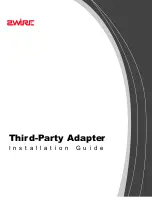
Chapter 1: Overview
48
Configuration Files
Stand-alone switches and stacks store their parameter settings in
configuration files in their file systems. The devices use these files to
configure their parameter settings whenever they initialize their
management software, such as when you power on or reset the units.
The switches do not update the files automatically after you change a
parameter setting. Instead, you must update the files by performing save
commands in the management software. Once the parameter settings are
saved in the configuration files, they are retained even when the switches
or stacks are powered off.
You can upload the configuration files to a workstation or a TFTP server
for editing or to maintain a history of the configurations of the switches or
stacks.
Stand-alone
Switches
All of the switches in the AT-9400 Series come with a default boot
configuration called BOOT.CFG for stand-alone operation. You can use
this file or you can create another one. Each stand-alone switch must have
its own configuration file, but you can transfer the files if you want different
switches to have similar configurations.
AT-9400Ts
Stacks
When the AT-9424Ts, AT-9424Ts/XP, and AT-9448Ts/XP Switches are
installed as a stack, they store their parameter settings in a single boot
configuration file on the master switch. This one file contains the settings
for all of the switches in a stack.
The default name of this file is STACK.CFG. The switches do not come
with this file, but the master switch automatically creates it when you issue
the SAVE CONFIGURATION command for the first time after you create a
stack.
Selecting a
Configuration
File
So how do the switches know which file to use? The AT-9400 Switches
that can be used only as stand-alone units, such as the AT-9424T and
AT-9424T/POE Switches, always use the BOOT.CFG file or its
designated equivalent file.
The AT-9424Ts, AT-9424Ts/XP, and AT-9448Ts/XP Switches, which
support both stand-alone and stack operations, select a configuration file
based on their stack ID numbers. If the stack ID number is set to AUTO,
meaning automatic, the switch assumes that it is a stand-alone switch and
should use the BOOT.CFG file, or whatever stand-alone file you’ve
designated. This is the default setting for the switches.
If the stack ID is set to STATIC, the switch assumes that it is part of a
stack and that it should obtain its settings from the master switch. For
more information, refer to “Stack Configuration Files” on page 71.
Содержание AT-S63
Страница 14: ...Figures 14 ...
Страница 18: ...Tables 18 ...
Страница 28: ...28 Section I Basic Operations ...
Страница 58: ...Chapter 1 Overview 58 ...
Страница 76: ...Chapter 2 AT 9400Ts Stacks 76 Section I Basic Operations ...
Страница 96: ...Chapter 5 MAC Address Table 96 Section I Basic Operations ...
Страница 114: ...Chapter 8 Port Mirror 114 Section I Basic Operations ...
Страница 116: ...116 Section II Advanced Operations ...
Страница 146: ...Chapter 12 Access Control Lists 146 Section II Advanced Operations ...
Страница 176: ...Chapter 14 Quality of Service 176 Section II Advanced Operations ...
Страница 196: ...196 Section III Snooping Protocols ...
Страница 204: ...Chapter 18 Multicast Listener Discovery Snooping 204 Section III Snooping Protocols ...
Страница 216: ...Chapter 20 Ethernet Protection Switching Ring Snooping 216 Section III Snooping Protocols ...
Страница 218: ...218 Section IV SNMPv3 ...
Страница 234: ...234 Section V Spanning Tree Protocols ...
Страница 268: ...268 Section VI Virtual LANs ...
Страница 306: ...Chapter 27 Protected Ports VLANs 306 Section VI Virtual LANs ...
Страница 320: ...320 Section VII Internet Protocol Routing ...
Страница 360: ...Chapter 30 BOOTP Relay Agent 360 Section VII Routing ...
Страница 370: ...Chapter 31 Virtual Router Redundancy Protocol 370 Section VII Routing ...
Страница 372: ...372 Section VIII Port Security ...
Страница 402: ...Chapter 33 802 1x Port based Network Access Control 402 Section VIII Port Security ...
Страница 404: ...404 Section IX Management Security ...
Страница 436: ...Chapter 36 PKI Certificates and SSL 436 Section IX Management Security ...
Страница 454: ...Chapter 38 TACACS and RADIUS Protocols 454 Section IX Management Security ...
Страница 462: ...Chapter 39 Management Access Control List 462 Section IX Management Security ...
Страница 504: ...Appendix B SNMPv3 Configuration Examples 504 Security Model Security Level Storage Type SNMPv3 Parameters Continued ...
Страница 532: ...Appendix D MIB Objects 532 ...
















































